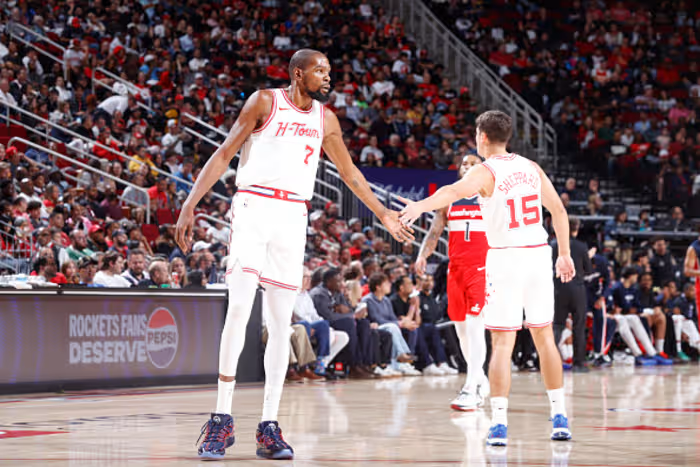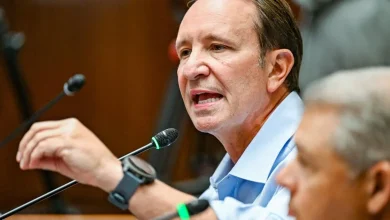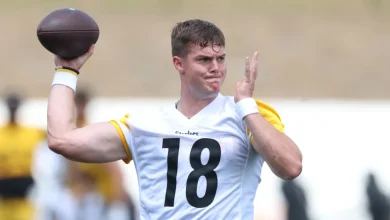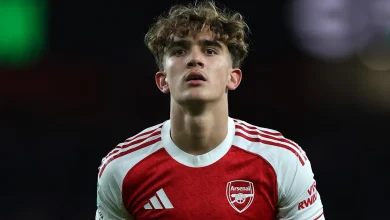The 10-Game Report: Are the Rockets really the NBA’s best shooting team?

The Houston Rockets have now played 10 games in the 2025-26 NBA season, and we’re starting to get a clearer picture of what to expect from this team over the next seven-ish months.
The season got off to a less-than-optimal start, as the team dropped a 125–124 double-overtime thriller against the defending champion Oklahoma City Thunder. Then in Game No. 2, they went cold late and lost to the Detroit Pistons, 115–111. That left them 0–2 with a point differential of only -5.
Fast-forward three weeks, and the Rockets now sit at 7–3, good for the No. 4 seed in a Western Conference that looks as loaded as ever.
Here are some of my takeaways:
Threes are falling for almost everyone!
If you had to point to the most surprising contribution to Houston’s early-season success, it would have to be the squad’s lethal accuracy from deep.
The Rockets aren’t leaning on the three-ball the way you might expect. Their average of 13.0 made threes per game ranks just 19th in the league (for reference, the New York Knicks lead the league at 16.5 makes per contest). But here’s the catch: they’re attempting only 29.9 threes per game — the lowest mark in the league by more than one full attempt.
If math isn’t your thing, that means they’re shooting 43.5% from three as a team — the best mark in the league by nearly three percent.
That is ridiculous efficiency, especially considering the cast of characters that’s shooting the hell out of the basketball. It was more or less assumed that Kevin Durant and Jabari Smith Jr. would bury some triples, but we’ve seen other guys knocking them down like never before.
Tari Eason has been a demon from the corners. A career 36.5% three-point shooter, he is hitting 53.1% on nearly five attempts per game this season.
Josh Okogie — who Houston brought in over the summer on a $3.1 million veteran minimum deal — is shooting 46.9% from deep, more than 16% higher than his career average.
And finally, where do you even begin with Alperen Şengün? The triple has never been a reliable accessory to Alpi’s game, much to the chagrin of fans who envisioned the spacing potential created by Nikola Jokić — a player with comparable playmaking ability and legitimate three-point range.
Şengün clearly worked on his jumper over the summer. He’s up to 1.3 attempts per game after never eclipsing 0.5 attempts through his first four seasons. And what’s crazy is that he’s making them — hitting 41.9% from three after entering the season with a career average of 28.3%.
That’s a huge credit to Şengün and the Rockets’ staff, with the star seemingly turning a weakness into a strength in just one offseason.
Alperen Şengün and KD are paving paths to repeating as All-Stars
Despite having the second-best record in the West last season, the Rockets had just one All-Star: Alperen Şengün. This offseason, the team finally provided him with a proven co-star in Kevin Durant, who made his 15th All-Star team last season.
So far, the pairing has been heavenly.
They’re the team’s two leading scorers (Durant: 24.6 PPG; Şengün: 22.1 PPG) and two of the team’s three leading distributors (Şengün: 7.2 APG; Thompson: 5.6 APG; Durant: 3.2 APG).
But don’t just take the numbers alone — listen to KD himself.
In an exchange on X (which KD loves to partake in), Durant said he has found himself missing uncharacteristic shots this year because he’s surprised at how open he is. He credited Şengün’s gravity for those improved looks.
Brother, can’t believe it lol. Sometimes I’m surprised I’m that open and start brickin…28 just sees everything.
— Kevin Durant (@KDTrey5) October 30, 2025
“We’re still figuring things out too,” Durant added in another reply.
Reed Sheppard is getting better — and fast
When I was gushing over the Rockets’ three-point shooting earlier, I intentionally left out a glaring name: Reed Sheppard. In this author’s opinion, his improvement deserves its own section.
This season, Sheppard is shooting 50% from three on a team-leading 5.6 attempts per night.
Sheppard faced a lot of criticism last season and throughout the summer. Even in a relatively weak draft class, his limited usage and production as a rookie were viewed as below par for a No. 3 overall pick — especially as Stephon Castle (selected by San Antonio one pick later) blossomed into a reliable part of the Spurs’ rotation.
Now in Year 2, it seems the doubters may have sold their stock a bit early.
The Rockets have given Sheppard roughly 22 minutes per game — the most of any reserve not named Tari Eason. More importantly, Reed has had the freedom to play his game.
He’s taken advantage of that time, attempting 5.6 threes per game (up from 2.7 last year). And he’s not just catching and shooting. We’re seeing side-steps, step-backs, and self-created looks off the dribble. That kind of shot-making was all over his Kentucky tape, and it’s nice to see it translating to the next level.
The shooting remains the selling point, but Sheppard clearly didn’t spend the offseason just playing H-O-R-S-E. With the ball in his hands, he has been running motion, setting up teammates, and looking more comfortable as a facilitator — even if there are still some learning-curve turnovers.
Defensively, he’s still a weakness — not surprising for a guard of his size — but he hasn’t been a complete negative. If you dribble or pass the ball carelessly, Sheppard can make you pay, and his low center of gravity helps him poke steals from bigger players.
Sheppard’s pesky steals feel straight out of his Kentucky highlight reel, especially when they spark his signature fast breaks and barely rim-clearing dunks.
The squad could still really use a primary ball handler — but they’re making do
Losing Fred VanVleet to an offseason ACL tear was brutal — especially in September when free agency was basically over. The team still feels that loss. But through 10 games, they’ve shown they can survive, and even succeed, without their floor general of the past two seasons.
After the injury, the big offensive question was: “Okay, so who’s going to dribble the basketball?”
Through 10 games, the answer has more or less been: everyone.
The Rockets have leaned into a point-guard-by-committee approach. Sheppard and Okogie have shared the reins, and Amen Thompson — listed as a point guard on draft night but more often slotted at forward — has been moved back to the one. Durant handles the rock plenty too, as expected.
Şengün even brings the ball up the floor on occasion, making the Jokić comparisons even stronger. He also had an ridiculous dribble-drive blow-by against a clamping Giannis Antetokounmpo to deliver the finishing blow in a come-from-behind win over Milwaukee.
So the question becomes: “That all sounds great, but is it working?”
In a small sample size, the answer is somewhat concerning.
Their turnover rate is among the worst in the league (17 per game, 27th), and their opponent turnover percentage isn’t much better (12.3%, 22nd). Their elite shooting has covered up those flaws — but only to a point.
Can Houston keep up this insane shooting? They’ve beaten some teams with rough-looking records during this hot stretch (Brooklyn at 1–10; Dallas at 3–9; Memphis at 4–9; Washington at 1–11), so it’s reasonable to assume the efficiency will cool off against stronger competition.
We’ll check back in after another 10 games to see how things are looking.
Copyright 2025 by KPRC Click2Houston – All rights reserved.





